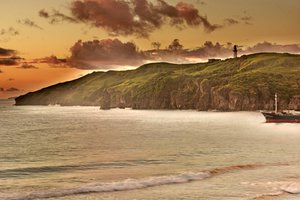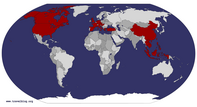Advertisement
Published: July 30th 2013

 Basco Sunset
Basco Sunset
The Basco Lighthouse is perched on top of a cliff with skies awash with warm colors as the sun dips into the horizon. It’s early morning. Coming out of our guesthouse to look for a place where we can have breakfast, a laid-back vibe fills the surprisingly warm air. As we navigate the relatively narrow streets of the town, a man on a bicycle greets us. Around us the rustic houses bathe in sunlight as they stand along the national highway that’s practically devoid of any form of transport with more than two wheels. Behind us is the imposing presence of a mountain foregrounding the blue sky. In front of us the turquoise ocean beckons with its calmness.
This pleasant introduction weather-wise isn’t exactly what we have in mind. I and my three companions – Faith, CJ and Eunice – are in Basco, the capital town of Batanes, the Philippines’ northernmost and smallest province. Though well known for its raw beauty and indigenous culture, Batanes gets far less visitors than most provinces, in large part due to its remoteness and the reputation of its weather. A group of ten islands – three of them inhabited – smack in the center of the waters between Luzon and Taiwan, the province fills the imagination of many Filipinos as a place of storms. In fact, we’ve

 Marlboro Hills
Marlboro Hills
Kuya Romy is dwarfed by the landscape of Batanes, an island featuring verdant rolling hills and dramatic ocean scenery.had garnered a lot of surprised reactions when people learned that we would be going here in July, during the Philippines’ typhoon season.
It’s hardly surprising, then, that the good weather catches us a bit off-guard, especially when it was raining when we left Manila. “It’s a common misconception among mainlanders that Batanes is constantly battered by typhoons,” I remember our guide Romy Nerida said while walking us out of the airport and into our guesthouse. “The weather is fickle – rain, shine, rain, shine – but we seldom have a typhoon here.”
So it turns out that despite heaps of information from various sources and stories from friends who have been here, I never really know Batanes. My casual interest has now evolved into a desire to explore the islands more. To surrender to the place. To leave all cares and – as a celebrity said of himself after a much-publicized breakup – just hope to find myself in order to be happy.
……….
Kuya Romy kneels to inspect the blocks of wood that have been placed on a fence. He removes the blocks, places them on the grass and motions for us to follow

 Tukon Church
Tukon Church
A romantic view framed by one of the Tukon Church's doorway. The five-year-old church is a relatively new one in Batanes but has become already very popular among couples planning their weddings.him. To
Kuya Romy – a former government employee who now moonlights as a freelance guide when not tending the crops in his farm – no place in his hometown is off-limits. That’s largely how it is here; everyone knows everyone, and everyone is accountable for everyone.
Kuya Romy knows who owns the supposedly private area and assures us that the fences are merely to keep cows from eating the newly planted garlic bulbs.
Under the golden afternoon sun, our guide is giving us a visual tour of the area around the Basco lighthouse. Nodding to the cliff a few meters away, he says, “That’s the main port of Batanes. Over that hill is the airport.” I suck in trigonometry so
Kuya Romy loses me when he mentions something about how pilots dread the runway’s inclination. What I can surmise from what he says is that it’s tough being a pilot with a Basco flight.
Everything we’re shown in our first afternoon seems unbelievably delightful. The Vaiang Rolling Hills, with its sun-dappled grasses, howling winds, friendly livestock and a majestic view of the ocean waves crashing into the steep cliffs. The sweeping views of the hills at the

 Savidug Town
Savidug Town
Traditional stone houses line the streets of the UNESCO-nominated town in Sabtang Island. The houses were built to withstand typhoons.end of the Dipnaysupuan Japanese Tunnel. More stunning panorama at the local office of the Department of Science and Technology. The very romantic ambiance of the Tukon Church in the late afternoon. Even the views of the Basco skyline and Mt. Iraya from our guesthouse’s rooftop.
As night finally arrives, we poke around the stores of Basco. There’s no sense of dread in wandering the unlit streets, especially when residents tout their province’s zero crime rate. In any other place, it rings as an overly optimistic proclamation, though here, where you don’t feel any hostility or cynicism from the locals, it’s hard not to take it as truth.
We have dinner later at Casa Napoli, which, according to
Kuya Romy, was born out of love. The restaurant is owned by a couple who met because of mutual love for pizza, with the husband – Xavier Mirabueno – a former chef on a cruise ship. The restaurant’s fame lies in part on its fresh dough and ingredients, all prepared only after an order is placed. But the charmingly rustic mood and hospitality of the place may have contributed as well.
Here, life is good. So is the pizza.

 Chamantad-Tinyan Sitio Viewpoint
Chamantad-Tinyan Sitio Viewpoint
Nicknamed "Photographer's Cove," the Chamantad-Tinyan Sitio Viewpoint delights photographers with spectular panoramic views of Batanes...........
Sabtang Island, though only 25 minutes by
falowa (Ivatan boat) from the main island of Batan, seems to be a world away. Visitors brave the notorious waters around the Batanes archipelago and troop to the smallest of Batanes’ inhabited islands for two things – raw Ivatan culture and the striking scenery around the coastline. Today we’re doing both.
Fueled by instant noodles and instant coffee from the Honesty Coffee Shop – a store famous for having no one to watch over the shelves and instead trusts customers to leave their payment for whatever they take – we make our way to the port where our
falowa is docked. After an uneventful boat ride, we disembark in Sabtang’s port in Centro, register our names at the tourist information center and board a stainless Tamaraw (a Filipino vehicle that’s sort of a cross between a small truck and a jeepney) to the village of Savidug.
Named after a local breed of almond, Savidug’s renown lies entirely on the adorable traditional houses lining its tiny streets. The famous Ivatan stone houses, which were built specifically to withstand typhoons, were actually introduced by the Spaniards during colonial times. “Ivatans

 Fundacion Pacita
Fundacion Pacita
The famous resort sits atop a hill overlooking stunning views. The place was formerly the home of the acclaimed artist Pacita Abad, who died of colon cancer in 2004.used to build their houses only with cogon grass,”
Kuya Romy says, “but the Spaniards taught them to use limestone from the sea. Eventually, only the roofs retained the cogon.”
As Ivatans struggled to balance modernization with tradition, many of the houses were neglected and even abandoned, with residents choosing to build dwelling structures with more modern materials. Some have even crumbled to the ground. The famed headpiece
vakul, worn by women as protection from the natural elements,
isn’t a common sight nowadays, except in souvenir stores.
Kuya Romy nonetheless remains hopeful and believes that the nomination of Savidug as a UNESCO Heritage Site will be the incentive needed to preserve one of the Philippines’ cultural treasures.
An hour later, we depart for the Chamantad-Tinyan Sitio. Or as
Kuya Romy calls it, “The Photographer’s Cove.” The reason for the nickname is obvious. The wide, undulating landscape is only matched in majestic beauty by the raging waters below the towering cliffs, and the landscape is an overwhelming match for me and my camera.
We have our lunch at Nakabuang Beach a few kilometers from the other side of Centro, filling our stomachs with freshly caught lobster and fish.

 Valugan Beach
Valugan Beach
Large boulders greet the waves of the Pacific Ocean.Then we rush to the beach, enjoying the ocean and its crashing waves. Batanes’ unpredictable weather has often stranded visitors when winds become too strong for even the sturdy Ivatan boatmen to overcome. But the weather has been nice to us so far, so after a few minutes,
Kuya Romy calls us. The boat is ready to depart to Batan Island. We need to go.
The mountainous terrain serves as a reminder of Batanes’ volcanic origins. But it’s the lush vegetation and extraordinary sceneries of the province that strongly suggest why the Ivatan people, when their ancestors left Taiwan, chose to settle here. Geographically isolated, lashed in both sides by the Pacific Ocean and the South China Sea (er, the West Philippine Sea), and teeming with natural resources, Batanes has captured the imagination of Filipinos and foreigners alike.
This is a place where you come to visit and end up wanting to stay.
……….
Batan Island is more than its capital Basco. On our last day,
Kuya Romy takes us around the other parts of the island, including the Marlboro Hills (the more popular name for Racuh a Payaman). It’s another site of wide expanse of

 Mt. Iraya
Mt. Iraya
Clouds cover the peak of Batanes' highest peak. Mt. Iraya is classified as an active volcano, though it hasn't erupted for more than six centuries.rolling hills with ocean views, though arguably it’s also the best.
Walking along the grass,
Kuya Romy surveys the wide expanse of waters below us. He calls someone at the shore and gives a wave. A strong wind blows but our guide is unconcerned, despite standing so close to the edge. Nothing can shake his confidence, not when he has mastered every nuance of the island.
The island is his home. And for the past three days, he has made it feel like it is to us, too.
Advertisement
Tot: 0.221s; Tpl: 0.017s; cc: 14; qc: 32; dbt: 0.1384s; 1; m:domysql w:travelblog (10.17.0.13); sld: 1;
; mem: 1.2mb



























D MJ Binkley
Dave and Merry Jo Binkley
Exploring the frontier
Excellent photography. Wish we were out there with you!